From the Buffa et al. 2022 abstract:
“The postcranial skeleton of the gliding neodiapsid reptile Coelurosauravus elivensis (Lower Sakamena Formation, ?upper Permian, southwestern Madagascar) is re-described in detail based on all previously referred specimens.“
Correction: Adding taxa, as in the large reptile tree (LRT, 2145 taxa) separates Diapsida (Petrolacosaurus and kin within the Archosauromorpha) from Lepidosauriformes (Coelurosauravus and kin within the Lepidosauromorpha). The diapsid skull morphology is convergent, so don’t be fooled. Use a last common ancestor method to determine systematics and phylogeny. Traits too often converge.
BTW, the LRT recovered this over a decade ago, which goes to show how painfully slow universities and their Benton Vertebrate Paleontology textbooks are in keeping up to date while perpetuating invalid myths.
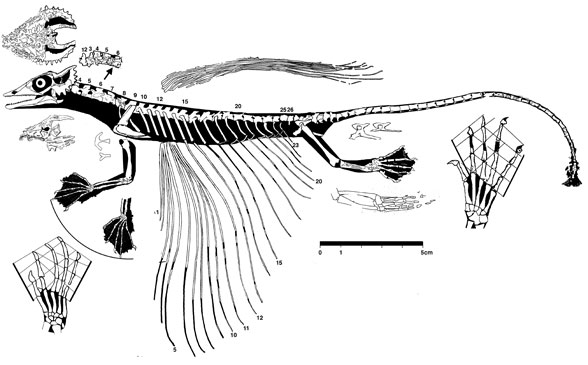
Buffa et al. 2022 continue:
The exquisite preservation of the material provides three-dimensional details of the individual bones, which are missing in the Laurasian weigeltisaurid material. A new skeletal reconstruction of C. elivensis is proposed including the first reconstruction of a weigeltisaurid reptile in lateral view.
Actually not the first such reconstruction. ReptileEvolution posted one (Fig. 1) online over a decade ago. Others are time-stamped after posting on this blog (see links below). Even so, there is no indication that the Buffa et al reconstruction was traced from the fossil. It includes several errors largely due to using the freehand method, which pays little attention to the material data, but does deliver a decent impression of it, like an impressionist painting.
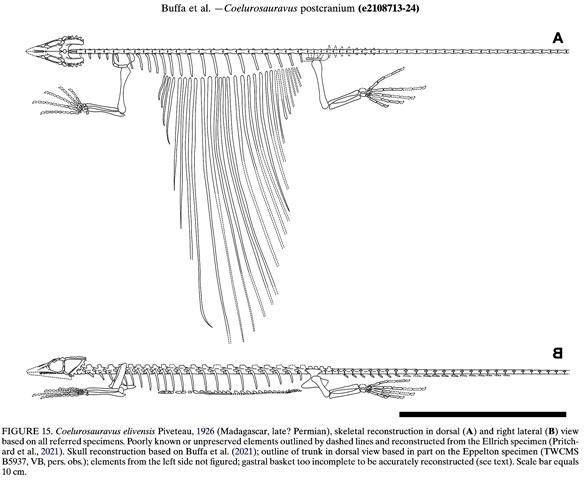
Buffa et al. 2022 continue:
“The re-examination of the material highlights interspecific differences in the postcranium of weigeltisaurids, in particular in the trunk and patagial spars. These animals have long been considered as arboreal and gliding reptiles. However, new information on the postcranium of C. elivensis reveals strong similarities with both extant and extinct quadrupeds specialized for a clinging arboreal lifestyle.
Why can’t it be both gliding and clinging, convergent with Draco (Fig 3)?
Buffa et al. 2022 continue:
“Additionally, the presence of an additional phalanx in the fifth digit of the manus is now attested for all weigeltisaurids where this region is preserved.
This is an error. The phalanges were imagined (dashed lines) in the Buffa et al reconstruction (Fig 4) and the metacarpus was flipped to more closely match typical lepidsaurs. In extinct gliding reptiles metatarsal 2 is the longest and the phalangeal formula is a typical 2-3-4-5-4 as shown in both the Peters reconstruction and the Buffa et al restoration. No ‘extra’ phalanges.
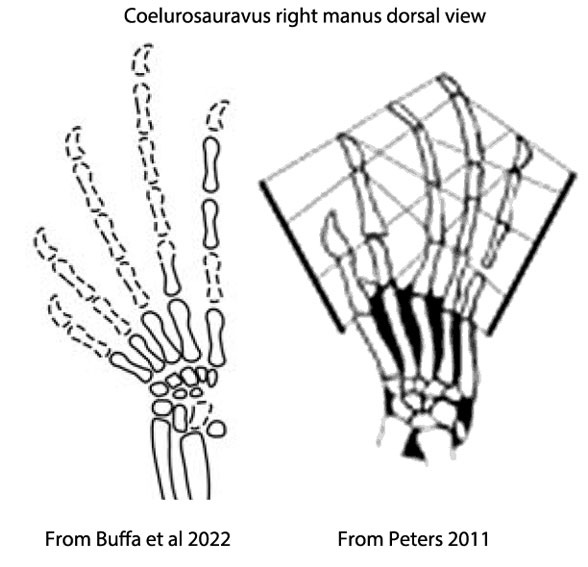
Buffa et al. 2022 continue:
“We suggest that this morphology could have allowed weigeltisaurids to grasp their patagium as observed in the extant gliding agamid Draco.
As reported here in 2016, “(Dehling 2016) reported, “the patagium is deliberately grasped and controlled by the forelimbs while airborne.” Evidently this ‘membrane-grab’ behavior has not been noted before. I wondered if the rib skin is indeed grasped, or does the forelimb merely fold back against the leading edge of the patagium in a streamlined fashion? Photographs of climbing Draco specimens (Fig. 3) show that the patagium can fully extend without the aid of the forelimbs to stretch them further forward.
Photographs of gliding lizards (Fig 5 from Dehling 2016) show the forelimbs extended beneath the ribs, not anterior as required by Dehling and Buffa et al.
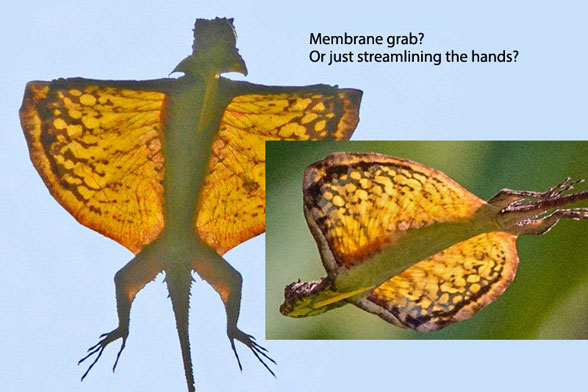
Buffa et al. 2022 continue:
“Weigeltisaurids are thus the earliest known gliding vertebrates and some of the first tetrapods with an obligatory arboreal lifestyle, but also represent the only known vertebrates with a hyperphalangy aligned with a gliding apparatus.”
How can they claim this? Even their imagined restoration (Fig 4) does not include an extra phalanx.
From the Buffa et al introduction:
“The anatomy of weigeltisaurids is unique with respect to their arboreal and aerial lifestyle.”
No it isn’t. Draco (Figs 3, 5) is convergent with those respects. Lead author, Buffa, is a young Masters student, but the older co-authors and editors should have caught this error.
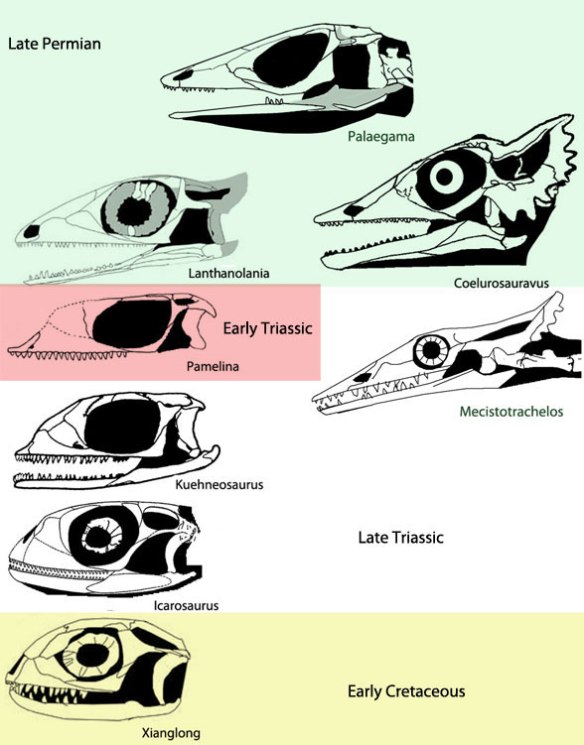
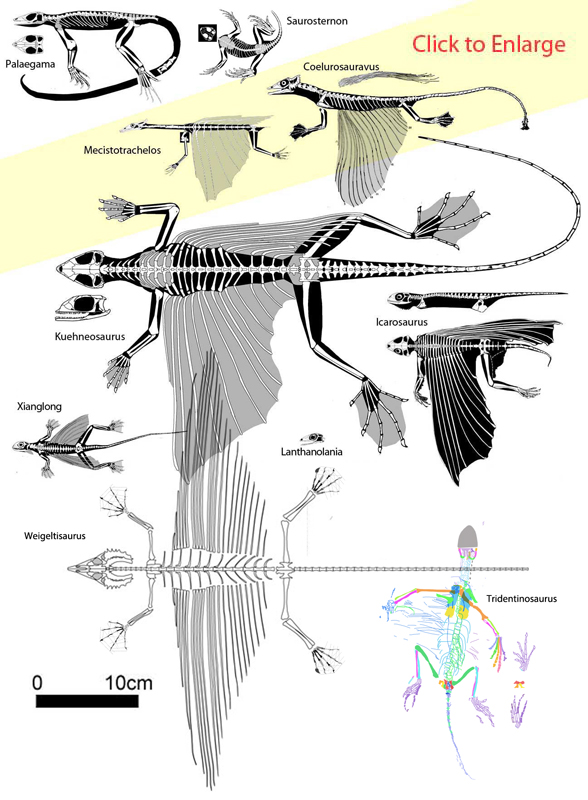
From the Buffa et al discussion:
“A reappraisal of the phylogenetic position of weigeltisaurids is currently under study by the authors, and is outside the scope of this paper.”
The LRT has already done this. Do not omit these taxa (Figs 6, 7).
Professors: don’t allow your masters students to make observations and publish work that includes faults such as those noted above. Here the co-authors shirked their responsibilities. Now Buffa will have to suffer this published embarrassment for the rest of his long career. At least google-search the taxon under study. Figure 1 will pop up.
References
Buffa V, Frey E, Steyer J-S and Laurin M 2022. The postcranial skeleton of the gliding reptile Coelurosauravus elivensis Piveteau, 1926 (Diapsida, Weigeltisauridae) from the late Permian Of Madagascar. Journal of Vertebrate Paleontology. Article: e2108713 online
Online posts from 2011 forward:


Add Saurophaganax
“Some paleontologists consider it to be a junior synonym and species of Allosaurus,” according to Wikipedea.
I’ve talked to people who worked with the material. Although it will probably nest with Allosaurus anyway, do I don’t think there’s a point in adding it.